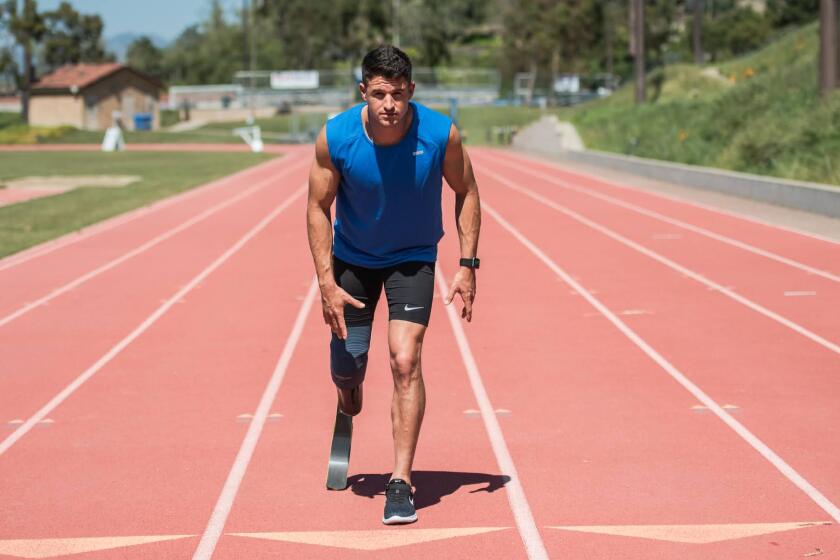Op-Ed: As I watch the Paralympics for pro tips, I realize I am one of them: A proud para-athlete

- Share via
My doctor, a former Paralympic wheelchair racer, told me there were two ways to get better after cancer and a related surgery that caused a spinal cord injury: heal and adapt. My legs no longer worked well but my arms did. She suggested a recumbent hand bike for me.
I had never thought much about the disabled athletic world. When I was an assigning editor at Outside magazine in the late 1980s, we’d sometimes receive queries from writers pitching a young person with a disability achieving something momentous. I was never quite sure how to handle them.
Back then, I think we editors were troubled looking at people with disabilities in pristine, sweeping wilderness landscapes. We believed the fantasies we trafficked didn’t quite square with someone who was so obviously (and unabashedly) different from us. Collectively, we weren’t very brave. I was just as bad as anyone else. I might’ve thought what my relative said when he first saw me post-op in 2015: “You poor bastard,” he said.
When the Rio Paralympics were held in 2016, a year after my injury, my singular focus was to be able-bodied again, fully healed. I was grinding on anti-gravity treadmills, among other rehab contraptions, and contemplating radical amputation and experimental implant surgery so I could walk independently again. I fell short.
But in watching the parading athletes entering the stadium last week for the opening ceremony of the 2020 Paralympics in Tokyo, I finally understood something. They weren’t “them”; they were me. I had up taken up handcycling after all.
Trenten Merrill is looking forward to competing at the Tokyo Paralympics as he strives to offer a message of hope for amputees and disabled persons.
In DVR-ing handcycling events for the rest of the week, I wasn’t watching just for inspiration, but I was looking at technique, gear, training regimens. I was trying to absorb the elements of their elite performances. The month before, I had even streamed the U.S. national handcycling events in Boise, Idaho, diligently trying to work out the winner’s pace so I could compare it to my own.
As recently as three years ago I had categorically rejected the suggestion of a handcycle. Then suddenly it was all I could do to not think about it. At the end of 2020, I sought out a para-athlete trainer to guide me in setting up a daily program. A grant from the Challenged Athletes Foundation paid for a zippy new $6,000 racing trike. Through winter and spring, I did endurance and strength workouts to work on stamina and develop speed.
Most of my training rides were solo. I didn’t see anybody who looked like me. At first I liked that, saw it as a badge of honor. A rebel rider. A hipster in my neighborhood flashed an affirming thumbs-up as I crested a hill. “Cool!” he exclaimed, “I like your low rider, bro.” I rode 2,500 miles through the first half of 2021.
But my sense of myself has been changing, a shift I couldn’t quite define until a challenging, 100-mile cancer charity ride a couple of weeks ago that had been my yearlong training goal. Being the only handcyclist on metro Boston roads with hundreds of upright riders made me feel, well, lonely. I craved low-riding, eye-level comradeship. When I saw the closest thing to an adaptive rider — tandem cyclists — I heard myself whoop with enthusiasm. I finished the ride in 7½ hours, my goal time. Then I collected my free tote bag and drove home.
I realized that being a lone wolf was no fun. And not very brave either. Afterward, I decided my next step would be sign up for an event with my brethren, men and women who weren’t so impressed by my pulling off a long ride. I wouldn’t be a novelty at say, Florida’s Swamp Classic, one of the events on the USA Hand Bike Circuit, but rather a competitor carving out a space along other competitors.
Truthfully, I have no idea where I belong — at some point there should be a classification process to align me with like-injured competitors. I might enter a road race or maybe the more popular lap-style criterium, hoping my 60 years earns me a forgiving age grouping. I suspect my work may be cut out for me, but bring it on.
The Paralympic athletes are no different from any other elite athlete, fighting for medals and career paydays, suffering through crashes and heartbreak. As I watched the hand-bike road races at the Fuji International Speedway, my wife warily eyed my sudden interest. “You will tell me if you are planning something?” she asked. I laughed and reminded her I’m not exactly Paralympic material at my age. “You seem younger,” she said sweetly.
In truth, I was doing more than planning. I had made a decision. I had adapted.
Todd Balf is the author of several books, including the memoir “Complications.”
More to Read
A cure for the common opinion
Get thought-provoking perspectives with our weekly newsletter.
You may occasionally receive promotional content from the Los Angeles Times.










